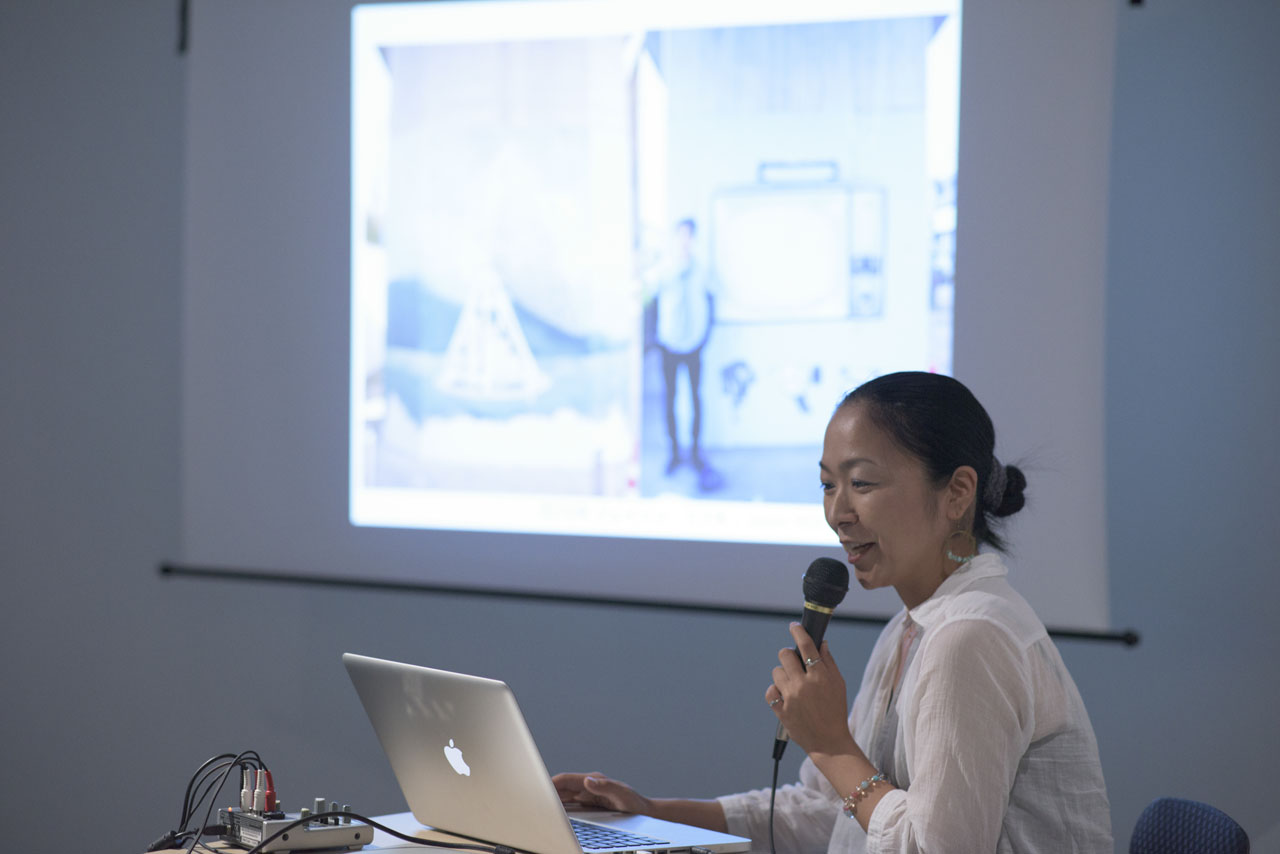主体性をもった輝き方にみる表現考察
石井瑞穂[アーカスプロジェクト コーディネーター]
「眼に見えないものを可視化する表現を具現化する。」2015年2月7日から3月7日までの1ヶ月にわたり実施した、人工衛星を利用して大地に星座を描く本プロジェクトは、鈴木浩之を中心に金沢美術工芸大学と宇宙航空研究開発機構(JAXA)第一宇宙技術部門の協力により行われた。「芸術と科学を身近に体験し楽しく学ぶプログラム」として、日本では最大規模の範囲/参加者により実現された(※2015年時点)。
一般から募った、つくば市・守谷市全20組のエントリーチームが、芸術と宇宙科学との関わりや地球観測衛星の仕組みをレクチャーで学び、地上に「星」を出現させるための装置「電波反射器(CR-コーナ リフレクタ)」をDIYで製作した。各チーム自ら考え、選んだ場所にCRを配置して構成される「星の集まり=星座」は、陸域観測技術衛星2号「だいち2号(ALOS-2)」が搭載するLバンド合成開口レーダ(電波)によって、宇宙から撮像(本書内では撮影)された。
撮像日の3月7日11時36分、守谷一帯は冷雨の降りしきる悪天候。で、快晴だった2月21日のつくば座撮像日より決して良い条件とは言えなかった。しかし628Km離れた衛星からの観測に映り込もうと、守谷だけでも300人近くの参加者が防寒ポンチョを被り雨雲の空を同時に見上げた。筑波山麓からJAXAまでの範囲に及んだつくば市も同様、観測記録に残されるその瞬間までの一連の過程は参加者のチームワークを要し、世代をこえて互いに教え学びあう構造を創出した。
全過程で延べ640名が関わる一方、「ニコニコ生放送」科学番組内では各過程が実況され1,800名を越える視聴者の関心を寄せ、コメントが残された。両市を大きなキャンバスに見立て、人工衛星が捉え浮かび上がらせた唯一無二の星座は主体性を機能させたといえる。
同年春、作品《つくば座》・《もりや座》を初公開し、一連の活動プロセスのドキュメント展を開催した。
東日本大震災の時に活躍した衛星「だいち(ALOS)」が観測した震災前(2011年)の元画像。今回、電波反射器を意図的に配置した参加者によって「町の変化」を起こした状況を撮像したのが、現在、地球を毎日観測している後継「だいち2号」の画像。
《つくば座》・《もりや座》は、作家がこの2つの衛星の観測画像の差分分析から生んだ新しい星座である。夜空のように地上に現れる変化の痕跡は、作家が意図しない形を想定し出現した。すなわち参加者の主体性が選んだ場所で、同じ通過時間、方角に合わせて衛星の観測軌道に映り込む行為によって形作られた。普段、絵を描く・観るのは苦手という人も、宇宙と聞くと興味を示す。絵画に例えれば星座を描くとき、自らが絵筆の先の素材(絵具の点)になり、支持体(地上)に載るポイントを自ら探し、絵に“成る行為”をしたとも言え、パフォーマティヴな現象が起きた。
会場では、ニコニコ生放送にて生中継された当時のワークショップや撮像日の様子を視聴し投稿された全国からのコメントが流れる動画のほか、実際に使用したCR、だいち2号のモデルとともに地球観測の仕組みがわかる資料等も展示された。会期中は関連企画ワークショップや、生憎雲天で観測中止となったが、春の星座についてレクチャーを開催した。アーカスプロジェクトは芸術家支援を目的に展開するが、この取組みは、作家を通して「元来、科学と芸術の分野が領域横断的範囲にない」根幹を参加者が理解する体験となり、作家へは次への新展開を促す機会となった。
誰もが地球環境を意識できる。地球が平穏な時のみ実施可能なこの取組みが、世界で継続されることを願う。
石井瑞穂
1973年生まれ。東京藝術大学大学院美術研究課程デザイン専攻修了。作家活動、レジデンス運営等を経て2012年より現職。2012年「ノアのはこぶ絵」企画。2014-2015年、地域プログラムにて本企画を実施。
Some Thoughts on an Expression That Shines Autonomously
Mizuho Ishii [Coordinator, ARCUS Project]
“Giving form to expression that visualizes the invisible” – this was the concept of this project, which used artificial satellites to draw constellations on land.
The project was carried out over the course of a month between February 7 and March 7, 2015, under the leadership of Hiroshi Suzuki, with the cooperation of the Kanazawa College of Art and Space Technology Directorate I at Japan Aerospace Exploration Agency (JAXA). As a program that gave people a chance to experience art and science in a close environment, and to learn in an exciting way in that process, this project was one of the largest ever in scope, both in area and in number of participants (*as of 2015).
A total of 20 teams from the cities of Tsukuba and Moriya, consisting of applicants from the public, attended lectures to study the relationship between art and space science, and the mechanism of Earth observation satellites. They then built their own wave-reflecting devices with which to create “stars” on land: corner reflectors (CR). The clusters of stars – the constellations – were composed of CRs set up at locations chosen by each team, which were then imaged from space by the L-band synthetic aperture radar installed on the Advanced Land Observing Satellite 2 (ALOS-2), otherwise known as Daichi 2. The imaging was scheduled at 11:36 on March 7, but the weather was poor across the whole Moriya area, with cold, unremitting rain; conditions were far from being better than on the imaging day of Tsukuba on February 21, when the skies were clear. Nevertheless, almost 300 people from Moriya alone gathered wearing thermal ponchos, and peered up at the rain clouds at the same time to be captured by a satellite 628 kilometers away. Similarly with the Tsukuba constellation, which stretched from the foot of Mt. Tsukuba to the JAXA premises, the sequence of events that led up to the moment of imaging required the teamwork of the participants, creating a structure of mutual teaching and learning that crossed generations. Besides the sum total of 640 people who were involved in the various stages of the project, over 1800 viewers watched and commented on the videos of each process that were streamed on Niconico Live’s
science program. The extraordinary constellations, which were captured and imaged by an artificial satellite using the two cities as large canvases, can be said to have drawn out the autonomy of their participants.
In the spring of the same year, the Tsukuba and Moriya Constellations were presented for the first time, along with an exhibition that documented the project’s processes.
The original images were those taken in 2011 before the Tohoku earthquake and tsunami by the satellite Daichi (ALOS), which was used to great effect in the aftermath of the disaster. And it was the satellite’s successor Daichi 2 – which is currently observing the Earth every day – that captured the images of the cities, transformed by the reflectors that had been deliberately set up by participants.
The Tsukuba and Moriya are new constellations that the artist produced through difference analysis of these two sets of satellite images. The traces of change, which appeared on the ground as if it were the night sky, were intended to form a shape that the artist could not have planned. To be exact, the shape was created by the participants who each chose their locations autonomously, and coordinated the times and angles in order to be captured by the orbiting satellite. Even people who do not enjoy producing or looking at paintings show an interest in outer space. To use a painting analogy, the participants who drew the constellations each became the material at the tip of the paintbrush (the drop of paint), choosing where to position themselves on the surface (the land), and engaged in an act of becoming a part of the painting. The result was a performative experience.
At the venue, visitors viewed footage of the workshop and of the imaging days, which had been broadcast live on Niconico Live, along with the comments that had been left by people all over the country. Also exhibited were the CRs that were actually used, a model of Daichi 2, and resources that illustrated the workings of Earth observation. During the exhibition period, ARCUS Project also held a workshop related to the project, and although the observation session was canceled due to cloudy weather, there was a lecture on constellations in spring. The ARCUS Project operates locally and internationally with the aim of supporting artists. The Constellation project provided participants an opportunity to understand, with support from the artist, that science and art not fundamentally distinct disciplines; at the same time, it encouraged the artist to pursue further development.
Everyone can have an awareness of the Earth’s environment. I hope that this initiative, which is only possible during times of peace, will continue to unfold around the world.
Mizuho Ishii
Born in 1973. Ishii graduated from the Tokyo University of the Arts, specializing in design at its Graduate School of Fine Arts. After her pursuing her own artistic practice, and running an artist-in-residence program, she assumed her current post in 2012. She has coordinated initiatives including the NOAA’s Art workshop in 2012, and Constellations of the Earth in 2014-2015.

No responses yet